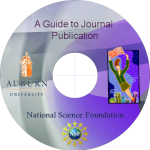

Review
The review process of the journal is designed to critically and objectively review your work and provide recommendation decisions regarding paper acceptance and suggestions for improving the paper. Reviewers are uncompensated peers who should be knowledgeable in the areas addressed by the paper. The peer review process is (ideally) objective and outcomes should not be taken personally.
Consider the following and also the sections on Acceptance Rates and Publication Timeline.
In general:
- Follow the submission guidelines to make sure your paper won't be rejected or slowed by logistical details.
- You should get some (short) acknowledgement of your submission, often with a tracking number and/or editor assignment. Usually these are now automatically generated through the internet.
- The editor may look over your references to determine a prospective referee. This referee may be an author you have cited in your paper. Reviewers with obvious conflicts of interest (same department, former student or advisor) will be avoided.
- The editor will also decide if your paper should be reviewed for the journal - papers which are clearly not appropriate or clearly not competitive for publication will be returned without review by the editor.
- Depending upon the journal, the review process could be either single-blind or double blind. Under the single-blind review the reviewer is made aware of the contributing authors, however, the author is not made aware of the reviewer. Under the double-blind review neither the reviewer nor the author are aware of the parties involved. Very rarely, the review process is totally transparent (that is, the author knows who the reviewers are).
- First reviews can take from three to twelve months. While this seems like a long time remember that there are many steps to be accomplished and you will only get your reviews after the slowest reviewer has finished.
- If you have not received first reviews within twelve months from the date of acknowledgment, contact the editor. You might contact the editor earlier depending on the track record and professed reviewing timeframe of the particular journal.
- When the review is completed, you will receive a report by internet (either as an email or by an emailed notification to access the reviewing website to view and download your reviews). In some cases the manuscripts may have markings on it. This is typically scanned and you will receive the marked manuscript as a file (or possibly a fax).
- You can expect to receive at least two reviews along with some comments by an editor. Occasionally only a single review is returned but this should be explained and justified by the editor. Typically, three reviews are returned. These will vary in detail, format and tenor dramatically. Usually, they are verbatim from the reviewer and so may include typos and grammatical errors. They are almost always "blind", that is, any information identifying the reviewer is removed. Many journals are also editor (or associate editor) blind. See the Correspondence Examples (Reviews) section of this CD for some real examples.
- On average, a referee spends two or more hours examining your paper. Save the reports you receive from the referee and incorporate his or her ideas into your revision. Using their advice is not considered plagiarism.
- Realize that the referee has a responsibility to be critical. Most comments will be deficits or mistakes in your paper rather than praise or admiration. This is the nature of peer review.
